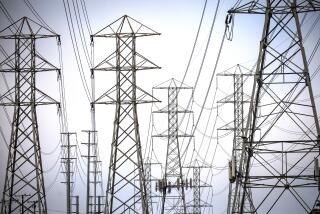CONSUMERS : Faulty Furnace May Cause High Gas Bill
- Share via
Question: My gas bill for January was $145. I have a small house. Also, the heat coming from the furnace felt more like cool air, not heat. I asked a man who is in the heating business why this should be.
He told me that the government not only deregulated gas but also the BTUs, and that they (the gas company) can now pipe gas with as much as half of it being air. Our rates have not come down, of course, just the heat. Is what my source says true? If it is, shouldn’t the gas company have to state on the bill what they are charging for air? I have no reason to doubt my source. He has been in the business in Texas for many years.--V.T.
Answer: And you’ve been brooding about this for several months? Your friend’s explanation is a fanciful one, but I’m sure you won’t be surprised to hear that the Southern California Gas Co. is a little appalled at the charge that it is “cutting” its gas with plain old air. First, though, what’s this BTU business?
BTU stands for British Thermal Units, and it’s a measure of the quantity of heat required to raise the temperature of one pound of water one degree at, or near, 39.2 degrees Fahrenheit, which is its temperature at maximum density.
Energy Content
And, according to Rich Puz, the utility’s public affairs issues coordinator: “We sell gas to the consumer on the basis of the BTU content, not on the basis of volume. That is, we’re charging on the actual energy content of the gas.
“Even if, somehow--and this doesn’t happen--the gas were diluted, the customer would still pay for it on the basis of the BTU content, not the volume,” Puz added.
The energy content is expressed in therms; typically, 1,000 cubic feet of gas will equal about 1 million BTUs.
Admittedly, Puz said, Southern California Gas buys gas from many natural gas suppliers and, due to geographical conditions, there will be slight variances in the energy content. “Instead of 1,000 cubic feet of gas equaling 1 million BTUs, some suppliers may produce a gas slightly over, or slightly under, that--maybe 5% in either direction. That’s why we have a ‘billing factor’ notation on the bill to adjust for this deviation. It may say that the volume measure should be multiplied by some figure like--this is hypothetical--1.000142.”
But whatever the adjustment, he added, the actual billing is based strictly on the energy content--the BTUs.
“It makes me think,” Puz said, “that there’s something wrong with her furnace. The minute it clicks on, the temperature to the hand should be very warm and pleasant--about 115 to 120 degrees. If it isn’t, then the condition of the furnace becomes suspect.”
In Your Favor
By waiting until summer to mention your suspicions, of course, you do have one thing working definitely in your favor: Southern California Gas has a standing offer to check out any customer’s furnace without charge, and this, certainly, is a far better time to take advantage of it than waiting until November or December, when everyone wants the service and when there can be a delay. Just look in the phone book for the Southern California Gas Co. office nearest you and ask them to send someone to check out your furnace.
Deregulation did, indeed, do some funny things to the natural gas industry, Puz said, but tampering with the BTUs wasn’t one of them.
Q: In a recent column about a time-share outfit sending out mailings designed to look like an official Internal Revenue Service mailing, you said that a tip-off was the “Bulk Rate” notation where the stamp should be, because no government agency sends out Bulk Rate mail.
This is wrong and should be corrected because I get a lot of official government mail--including those from the IRS--and most of it is, indeed, sent Bulk Rate.--D.S.
A: O.K. I’ll split the difference with you.
You’re right. Over the past few years, while my back was turned, more and more governmental agencies--the IRS, the Justice Department, the Department of Commerce, etc.--have, indeed, turned to bulk-rate postage for their routine and informational mailings, according to Dave Mazer, the Postal Service’s public information officer here.
“As a matter of fact, they’ve been encouraged to do this because it’s cheaper for the government,” he said.
Two stand-out examples: last year’s massive mailing to every address in the country on AIDS and AIDS prevention and the end-of-the-year mailing of everyone’s IRS Form 1040.
But I’ll stick to my original point: the government’s use of bulk-rate mailing is still confined to routine and informational material. Anything important--what a recipient might interpret as requiring a response on his part (the thrust of that particular column)--still goes out first class.
And here’s the tip-off: In the upper right-hand corner is either the uncanceled blue eagle (favored by the Postal Service) or the even more widely used “penalty” box (“Penalty for private use to avoid payment of postage, $300”).
In my book, the notation “Bulk Rate” in the upper right corner of the envelope--whether it’s from a governmental agency, or not--is still an instant disclaimer that the contents require any response.
Campbell cannot answer mail personally but will respond in this column to consumer questions of general interest. Write to Consumer VIEWS, You section, The Times, Times Mirror Square, Los Angeles 90053.
More to Read
Inside the business of entertainment
The Wide Shot brings you news, analysis and insights on everything from streaming wars to production — and what it all means for the future.
You may occasionally receive promotional content from the Los Angeles Times.










